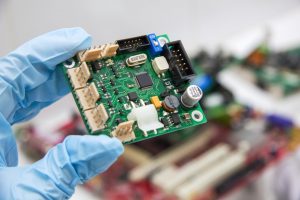Used in Flex PCB Fabrication
The primary materials used in flex PCB fabrication are primarily flexible dielectric substrates, copper foil, and conductive paste. The leading flexible dielectric substrate material is polyimide (PI) film. Unlike many thermosetting resins that soften upon heating, PI remains flexible, making it ideal for flex circuit construction. It also has better resistance to humidity and tears than standard FR-4, which makes it more durable for use in consumer and aerospace applications. PI is also known to have excellent electrical properties.
In addition to flex pcb fabrication, the material can be used for rigid-flex PCBs and flex-rigid boards, both of which combine rigid and flexible circuitry in one package. The choice of material depends on the design’s electrical, mechanical, and cost requirements. For example, high-speed designs require thinner flex boards with tighter bend radius. In addition, a lower thermal expansion is required for long-term reliability.
For a flex circuit, the base layer consists of a thicker flex or rigid-flex substrate material like epoxy fiberglass cloth, phenolic paper board, or steel plate. Often, this is backed by an insulation layer. The flex PCB may also have a coverlay, a protective layer that functions as solder mask. Coverlay can be additional PI film with adhesive, or it can be applied using an adhesiveless process called photoimageable solder mask. This is similar to screen printing and uses a photographic image of the solder pattern to expose it to the circuit.

Primary Materials Used in Flex PCB Fabrication
As a rule, copper is the leading conductor material in flex PCBs. However, it can be replaced with an alloy like aluminum, nickel, gold, or silver to meet specific electrical requirements. In some cases, these alloys can provide better performance, especially at higher speeds.
The etching and plating processes for flexible PCBs are identical to those of rigid-flex circuits. Drill holes are made in the same manner as for a two-sided rigid PCB core. Afterward, copper is deposited and chemically etched. The etching process can be done in a panel-plating mode or a pad-only-plating mode (button plating). Choosing the right method depends on your product’s design, application environment, and budget.
Since flex circuits have a tendency to expand and contract with temperature changes, it’s important to ensure that the drill-to-copper distance is adequate for your application. To do this, work with a PCB manufacturer that offers specialized testing equipment. A specialized fixture is also required for the assembly of a flex circuit, as these boards are not sturdy enough to hold themselves. This helps to eliminate errors and defects during the assembly and test phases of a circuit board.
This is especially vital for advanced manufacturing techniques, such as lithography and laser cutting. It’s also important to be aware that a flex circuit is not as stable as a rigid board when it comes to bending. Therefore, you should choose a material that is flexible and strong for your project’s design. It’s essential to have a good relationship with your PCB supplier so that you can communicate your design specifications clearly.